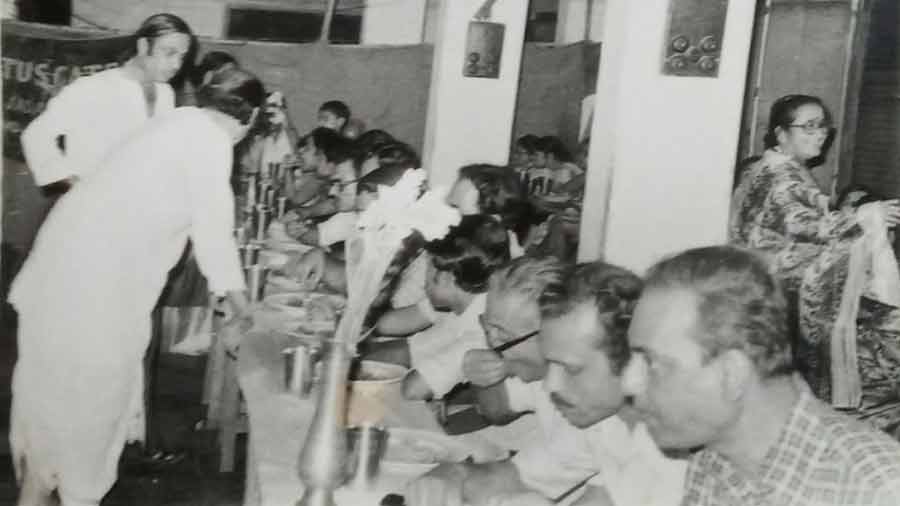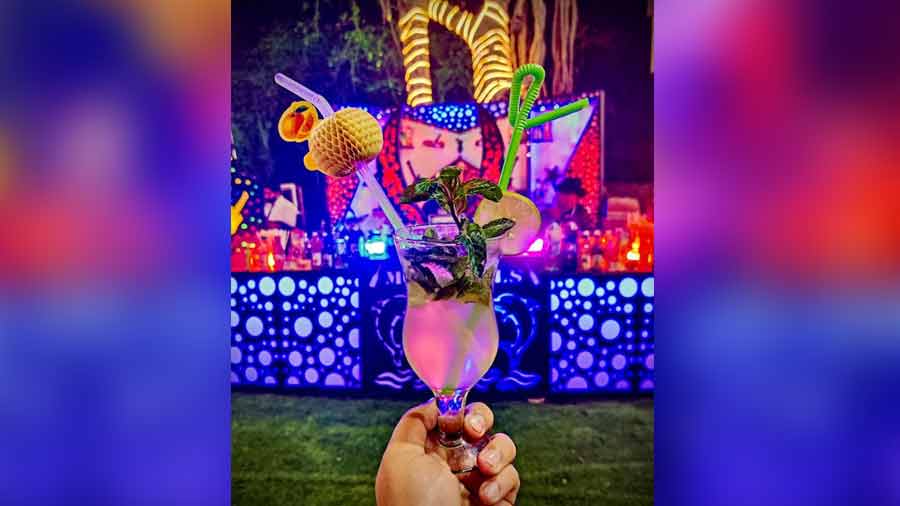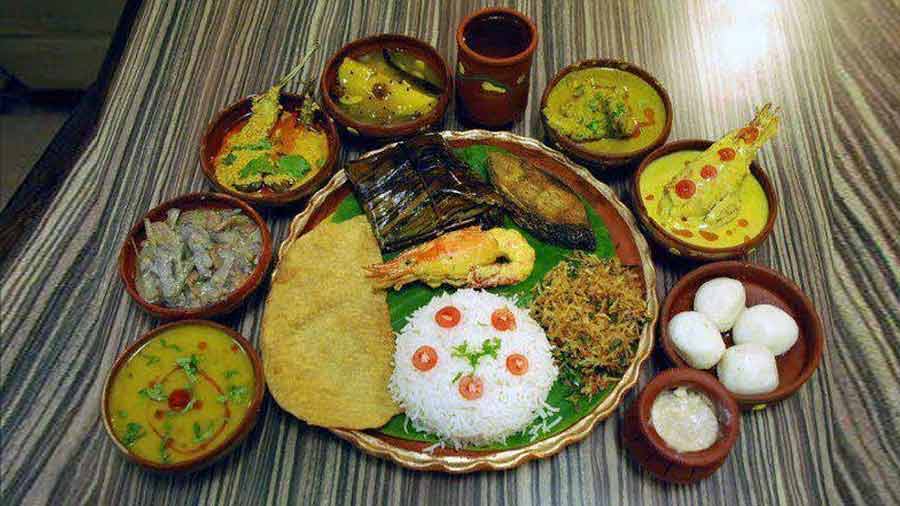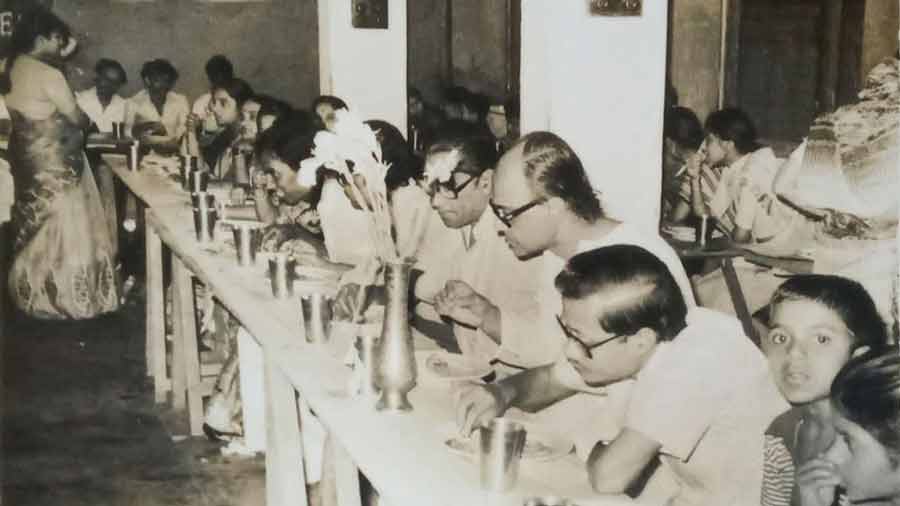As anyone who attended a Bengali wedding in Kolkata in the 1970s will attest, the menu for a traditional marriage, reception or any other similar function used to be a set piece. Beginning with begun bhaja and followed by luchi/kochuri and chholar dal, it used to end with sandesh, rosogolla and doi, with the mandatory mutton and fish items in between.
Families would have their favourite cooks camp at the venue a day in advance, who would sometimes take responsibility for preparing the desserts too. The food would be served by the male youths of the neighbourhood (parar chhele). Tying a gamchha around their waists and hurrying about with a bucket or tray of food in hand, they would serve the guests with utmost care.

The menu for a traditional marriage, reception or any other similar function used to be a set piece Courtesy: Pinaki Bhattacharya
Caterers like Bijoli Grill, Ananda Caterer, Guin Caterer and Bhoj Caterers were around then, but their services were mostly availed by wealthy families. However, there was hardly any difference in the menu, except maybe ice cream replacing mishti doi and mutton replacing chicken items. And the servers were in uniforms instead of gamchhas.
It was the Emergency that gave birth to the catering services that we know today. It was during the Emergency that for the first time there were restrictions on the number of guests. Family functions could no longer be a function for the locality too, as they all could not be invited. So, a common decision among many was to outsource the food service to a caterer. The increase in the cost per person was compensated by the smaller number of guests.

Making sure guests have had more than their fill is a tradition that has lasted Courtesy: Pinaki Bhattacharya
This opportunity was grabbed by the teachers of the Institute of Hotel Management, (the only catering school in Kolkata till the early ’90s), as they got a chance to have another source of income. Dishes like Fish Meuniere, Fish Orly, Chicken Marengo and many others were added to the menu straight from the practical classes of the catering college. Tamarind pulp used traditionally was replaced by citric acid to keep the colour of vegetarian items unchanged. Monosodium glutamate (MSG) was also brought in to enhance the taste. With these changes in the food and its preparation style, traditional cooks gradually lost their monopoly over the ‘function kitchen’. They surrendered and most of them joined various catering companies.

Another scene from the ’80s Courtesy: Pinaki Bhattacharya
The journey of catering in Kolkata has been quite eventful in the last couple of decades. Kolkatans’ tastes have changed and gone are the days of the conventional menu of luchi and mangsho on a banana leaf, and water in an earthen glass. Now, caterers of the city invent and reinvent dishes for every function. Eating at functions is no longer a community affair – individual attention is required now as everyone is ordering different items.
The service, with guests seated across long tables, was replaced by buffet counters, which now has been replaced by live counters. The live counters are the successors of the salad bar and dessert bar, which were introduced by Rongon Neogi of Continental Catering Services and some others in the early ’90s. Now, the demand for live counters is more than that of a regular buffet. Guests want fresh food, and that too, cooked in front of them. From south Indian, Peshawari and Mongolian to Burmese, Rajasthani and Lebanese, the range continues.

Live counters are all the rage these days Courtesy: Pinaki Bhattacharya
Except for some items like basanti pulao, kosha mangsho, biryanis and kormas, which are still just as popular today, other dishes have evolved a lot. For dessert, one prefers hot notun gurer sandesh with mihidana or notun gur topping. For welcome drinks, which was restricted to aam panna and readymade tea/coffee, the catering menu has graduated to the mocktail bar. As for tea and coffee, readymade cups no longer cut it. One has to add flavours there too — from cinnamon and cardamom to hazelnut and chocolate.

A mocktail bar is a common feature at most catered functions today @sweetnsourcateringservices/Instagram
Knowing that this is a trade where the profit margin is big, many have delved into this business where only few have succeeded. Fish Meuniere may have become Fish Munia courtesy para caterers, but it is the taste of the food and the satisfaction of the guest that decides the lifespan of a catering company.
It is said that Sushil Guin, of Guin Caterer, had to refuse a very important order once just because he didn’t get original Bhetki for fish fries – he didn’t want to compromise on his standards and ethics – an act that made him a legend in the industry. Today, with catering companies mushrooming, no one would dare refuse business based on ethics.

A Bengali fish thali from Guin Caterer @Guin Caterer Sushil Guin/Facebook
But ethics and high standards are precisely what helped veterans like Bijoli Grill, Guin, Ananda and Bhoj be of relevance even after 50 years. This tradition is carried forward by Pritam Datta of Asparagus, Sushanta Sengupta of 6 Ballygunge Place, Rongon Neogi of Continental Catering, Tarun of Sweet-N-Sour Catering, Prabal Hazra of Eastern Caterer and a few others. They have all learnt one basic truth about this business — you cannot bluff a Kolkatan gastronomically.
